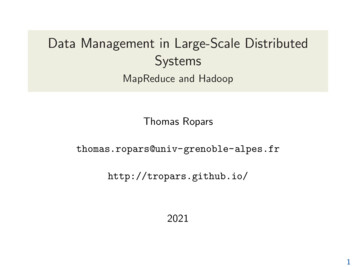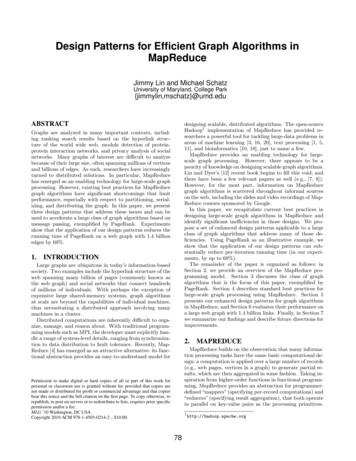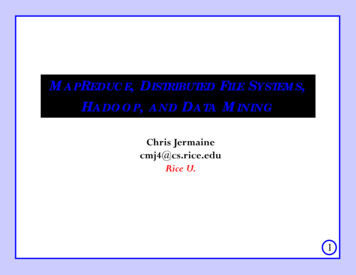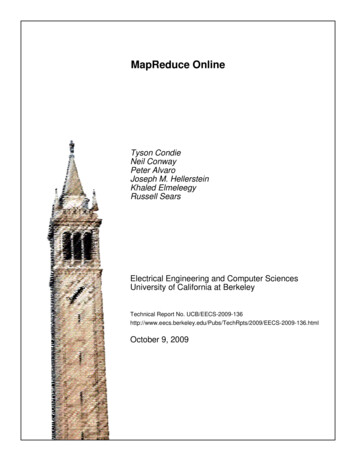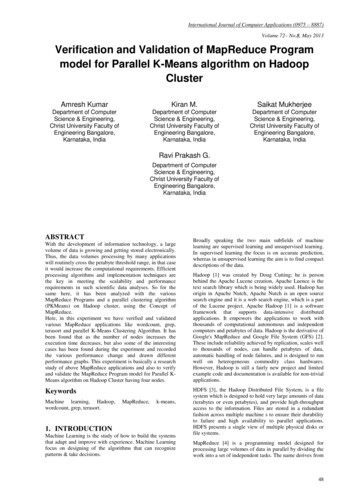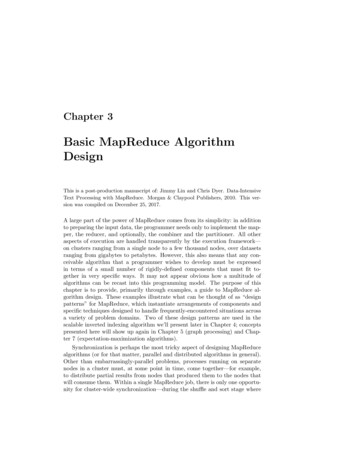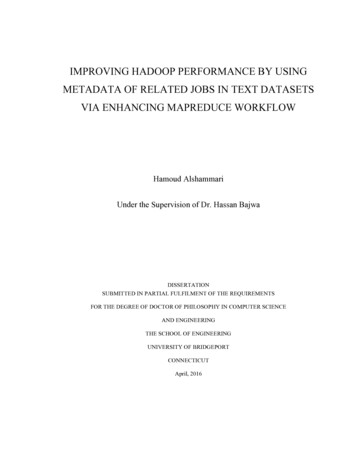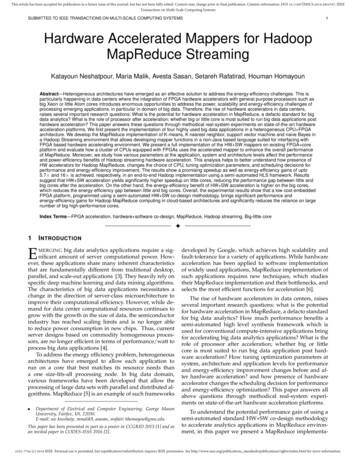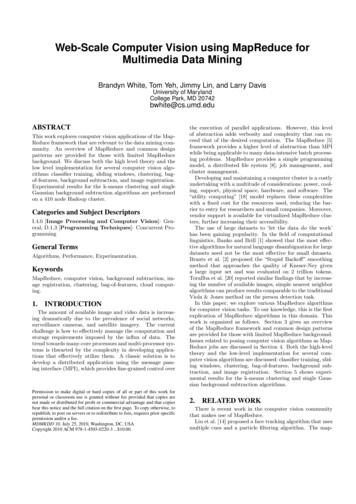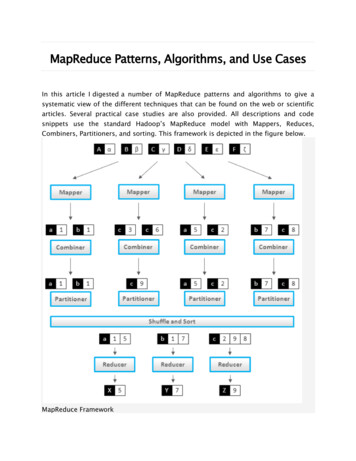
Transcription
MapReduce Patterns, Algorithms, and Use CasesIn this article I digested a number of MapReduce patterns and algorithms to give asystematic view of the different techniques that can be found on the web or scientificarticles. Several practical case studies are also provided. All descriptions and codesnippets use the standard Hadoop‟s MapReduce model with Mappers, Reduces,Combiners, Partitioners, and sorting. This framework is depicted in the figure below.MapReduce Framework
Basic MapReduce PatternsCounting and SummingProblem Statement: There is a number of documents where each document is a set ofterms. It is required to calculate a total number of occurrences of each term in alldocuments. Alternatively, it can be an arbitrary function of the terms. For instance,there is a log file where each record contains a response time and it is required tocalculate an average response time.Solution:Let start with something really simple. The code snippet below shows Mapper thatsimply emit “1″ for each term it processes and Reducer that goes through the lists ofones and sum them up:1class Mapper2method Map(docid id, doc d)3for all term t in doc d do4Emit(term t, count 1)567class Reducermethod Reduce(term t, counts [c1, c2,.])8sum 09for all count c in [c1, c2,.] do1011sum sum cEmit(term t, count sum)The obvious disadvantage of this approach is a high amount of dummy countersemitted by the Mapper. The Mapper can decrease a number of counters via summingcounters for each document:1class Mapper2method Map(docid id, doc d)3H new AssociativeArray4for all term t in doc d do5H{t} H{t} 16for all term t in H do7Emit(term t, count H{t})In order to accumulate counters not only for one document, but for all documentsprocessed by one Mapper node, it is possible to leverage Combiners:1class Mapper2method Map(docid id, doc d)3for all term t in doc d do4Emit(term t, count 1)
567class Combinermethod Combine(term t, [c1, c2,.])8sum 09for all count c in [c1, c2,.] do10sum sum c11Emit(term t, count sum)1213 class Reducer14method Reduce(term t, counts [c1, c2,.])15sum 016for all count c in [c1, c2,.] do1718sum sum cEmit(term t, count sum)Applications:Log Analysis, Data QueryingCollatingProblem Statement: There is a set of items and some function of one item. It isrequired to save all items that have the same value of function into one file or performsome other computation that requires all such items to be processed as a group. Themost typical example is building of inverted indexes.Solution:The solution is straightforward. Mapper computes a given function for each item andemits value of the function as a key and item itself as a value. Reducer obtains all itemsgrouped by function value and process or save them. In case of inverted indexes, itemsare terms (words) and function is a document ID where the term was found.Applications:Inverted Indexes, ETLFiltering (“Grepping”), Parsing, and ValidationProblem Statement: There is a set of records and it is required to collect all recordsthat meet some condition or transform each record (independently from other records)into another representation. The later case includes such tasks as text parsing andvalue extraction, conversion from one format to another.Solution: Solution is absolutely straightforward – Mapper takes records one by one andemits accepted items or their transformed versions.Applications:Log Analysis, Data Querying, ETL, Data ValidationDistributed Task Execution
Problem Statement: There is a large computational problem that can be divided intomultiple parts and results from all parts can be combined together to obtain a finalresult.Solution: Problem description is split in a set of specifications and specifications arestored as input data for Mappers. Each Mapper takes a specification, performscorresponding computations and emits results. Reducer combines all emitted partsinto the final result.Case Study: Simulation of a Digital Communication SystemThere is a software simulator of a digital communication system like WiMAX thatpasses some volume of random data through the system model and computes errorprobability of throughput. Each Mapper runs simulation for specified amount of datawhich is 1/Nth of the required sampling and emit error rate. Reducer computesaverage error rate.Applications:Physical and Engineering Simulations, Numerical Analysis, Performance TestingSortingProblem Statement: There is a set of records and it is required to sort these records bysome rule or process these records in a certain order.Solution: Simple sorting is absolutely straightforward – Mappers just emit all items asvalues associated with the sorting keys that are assembled as function of items.Nevertheless, in practice sorting is often used in a quite tricky way, that‟s why it is saidto be a heart of MapReduce (and Hadoop). In particular, it is very common to usecomposite keys to achieve secondary sorting and grouping.Sorting in MapReduce is originally intended for sorting of the emitted key-value pairsby key, but there exist techniques that leverage Hadoop implementation specifics toachieve sorting by values. See this blog for more details.It is worth noting that if MapReduce is used for sorting of the original (notintermediate) data, it is often a good idea to continuously maintain data in sorted stateusing BigTable concepts. In other words, it can be more efficient to sort data onceduring insertion than sort them for each MapReduce query.Applications:ETL, Data AnalysisNot-So-Basic MapReduce PatternsIterative Message Passing (Graph Processing)Problem Statement: There is a network of entities and relationships between them. It isrequired to calculate a state of each entity on the basis of properties of the otherentities in its neighborhood. This state can represent a distance to other nodes,
indication that there is a neighbor with the certain properties, characteristic ofneighborhood density and so on.Solution: A network is stored as a set of nodes and each node contains a list ofadjacent node IDs. Conceptually, MapReduce jobs are performed in iterative way and ateach iteration each node sends messages to its neighbors. Each neighbor updates itsstate on the basis of the received messages. Iterations are terminated by somecondition like fixed maximal number of iterations (say, network diameter) or negligiblechanges in states between two consecutive iterations. From the technical point of view,Mapper emits messages for each node using ID of the adjacent node as a key. Asresult, all messages are grouped by the incoming node and reducer is able torecompute state and rewrite node with the new state. This algorithm is shown in thefigure below:12class Mappermethod Map(id n, object N)3Emit(id n, object N)4for all id m in N.OutgoingRelations do5Emit(id m, message getMessage(N))678class Reducermethod Reduce(id m, [s1, s2,.])9M null10messages []11for all s in [s1, s2,.] do12if IsObject(s) then131415M selse// s is a messagemessages.add(s)16M.State calculateState(messages)17Emit(id m, item M)It should be emphasized that state of one node rapidly propagates across all thenetwork of network is not too sparse because all nodes that were “infected” by thisstate start to “infect” all their neighbors. This process is illustrated in the figure below:
Case Study: Availability Propagation Through The Tree of CategoriesProblem Statement: This problem is inspired by real life eCommerce task. There is atree of categories that branches out from large categories (like Men, Women, Kids) tosmaller ones (like Men Jeans or Women Dresses), and eventually to small end-of-linecategories (like Men Blue Jeans). End-of-line category is either available (containsproducts) or not. Some high level category is available if there is at least one availableend-of-line category in its subtree. The goal is to calculate availabilities for allcategories if availabilities of end-of-line categories are know.Solution: This problem can be solved using the framework that was described in theprevious section. We define getMessage and calculateState methods as follows:123class NState in {True 2, False 1, null 0}, initialized 1 or 2 for end-of-line categories, 0otherwise4567method getMessage(object N)return N.State
8method calculateState(state s, data [d1, d2,.])return max( [d1, d2,.] )Case Study: Breadth-First SearchProblem Statement: There is a graph and it is required to calculate distance (a numberof hops) from one source node to all other nodes in the graph.Solution: Source node emits 0 to all its neighbors and these neighbors propagate thiscounter incrementing it by 1 during each hope:12345678class NState is distance, initialized 0 for source node, INFINITY for allother nodesmethod getMessage(N)return N.State 1method calculateState(state s, data [d1, d2,.])min( [d1, d2,.] )Case Study: PageRank and Mapper-Side Data AggregationThis algorithm was suggested by Google to calculate relevance of a web page as afunction of authoritativeness (PageRank) of pages that have links to this page. The realalgorithm is quite complex, but in its core it is just a propagation of weights betweennodes where each node calculates its weight as a mean of the incoming weights:12class NState is PageRank345method getMessage(object N)return N.State / N.OutgoingRelations.size()678method calculateState(state s, data [d1, d2,.])return ( sum([d1, d2,.]) )It is worth mentioning that the schema we use is too generic and doesn‟t takeadvantage of the fact that state is a numerical value. In most of practical cases, we canperform aggregation of values on the Mapper side due to virtue of this fact. Thisoptimization is illustrated in the code snippet below (for the PageRank algorithm):12class Mappermethod Initialize3H new AssociativeArray4method Map(id n, object N)5p N.PageRank / N.OutgoingRelations.size()
6Emit(id n, object N)7for all id m in N.OutgoingRelations do891011H{m} H{m} pmethod Closefor all id n in H doEmit(id n, value H{n})1213 class Reducer14method Reduce(id m, [s1, s2,.])15M null16p 017for all s in [s1, s2,.] do18if IsObject(s) then1920M selse21p p s22M.PageRank p23Emit(id m, item M)Applications:Graph Analysis, Web IndexingDistinct Values (Unique Items Counting)Problem Statement: There is a set of records that contain fields F and G. Count thetotal number of unique values of filed F for each subset of records that have the sameG (grouped by G).The problem can be a little bit generalized and formulated in terms of faceted search:Problem Statement: There is a set of records. Each record has field F and arbitrarynumber of category labels G {G1, G2, } . Count the total number of unique valuesof filed F for each subset of records for each value of any label. Example:1Record 1: F 1, G {a, b}2Record 2: F 2, G {a, d, e}3Record 3: F 1, G {b}4Record 4: F 3, G {a, b}56Result:7a - 3 // F 1, F 2, F 38b - 2 // F 1, F 39d - 1 // F 210 e - 1 // F 2
Solution I:The first approach is to solve the problem in two stages. At the first stage Mapperemits dummy counters for each pair of F and G; Reducer calculates a total numberof occurrences for each such pair. The main goal of this phase is to guaranteeuniqueness of F values. At the second phase pairs are grouped by G and the totalnumber of items in each group is calculated.Phase I:12class Mappermethod Map(null, record [value f, categories [g1, g2,.]])3for all category g in [g1, g2,.]4Emit(record [g, f], count 1)5678class Reducermethod Reduce(record [g, f], counts [n1, n2, .])Emit(record [g, f], null )Phase II:123class Mappermethod Map(record [f, g], null)Emit(value g, count 1)4567class Reducermethod Reduce(value g, counts [n1, n2,.])Emit(value g, sum( [n1, n2,.] ) )Solution II:The second solution requires only one MapReduce job, but it is not really scalable andits applicability is limited. The algorithm is simple – Mapper emits values andcategories, Reducer excludes duplicates from the list of categories for each value andincrement counters for each category. The final step is to sum all counter emitted byReducer. This approach is applicable if th number of record with the same f value isnot very high and total number of categories is also limited. For instance, thisapproach is applicable for processing of web logs and classification of users – totalnumber of users is high, but number of events for one user is limited, as well as anumber of categories to classify by. It worth noting that Combiners can be used in thisschema to exclude duplicates from category lists before data will be transmitted toReducer.123class Mappermethod Map(null, record [value f, categories [g1, g2,.] )for all category g in [g1, g2,.]
4Emit(value f, category g)56789class Reducermethod InitializeH new AssociativeArray : category - countmethod Reduce(value f, categories [g1, g2,.])10[g1', g2',.] ExcludeDuplicates( [g1, g2,.] )11for all category g in [g1', g2',.]12131415H{g} H{g} 1method Closefor all category g in H doEmit(category g, count H{g})Applications:Log Analysis, Unique Users CountingCross-CorrelationProblem Statement: There is a set of tuples of items. For each possible pair of itemscalculate a number of tuples where these items co-occur. If the total number of itemsis N then N*N values should be reported.This problem appears in text analysis (say, items are words and tuples are sentences),market analysis (customers who buy this tend to also buy that). If N*N is quite smalland such a matrix can fit in the memory of a single machine, then implementation isstraightforward.Pairs ApproachThe first approach is to emit all pairs and dummy counters from Mappers and sumthese counters on Reducer. The shortcomings are: The benefit from combiners is limited, as it is likely that all pair are distinct There is no in-memory accumulations123class Mappermethod Map(null, items [i1, i2,.] )for all item i in [i1, i2,.]4for all item j in [i1, i2,.]5Emit(pair [i j], count 1)678class Reducermethod Reduce(pair [i j], counts [c1, c2,.])
9s sum([c1, c2,.])10Emit(pair[i j], count s)Stripes ApproachThe second approach is to group data by the first item in pair and maintain anassociative array (“stripe”) where counters for all adjacent items are accumulated.Reducer receives all stripes for leading item i, merges them, and emits the same resultas in the Pairs approach. Generates fewer intermediate keys. Hence the framework has less sorting to do. Greately benefits from combiners. s,ifnotproperly implemented. More complex implementation. In general, “stripes” is faster than “pairs”12class Mappermethod Map(null, items [i1, i2,.] )3for all item i in [i1, i2,.]4H new AssociativeArray : item - counter5for all item j in [i1, i2,.]6H{j} H{j} 17Emit(item i, stripe H)8910class Reducermethod Reduce(item i, stripes [H1, H2,.])11H new AssociativeArray : item - counter12H merge-sum( [H1, H2,.] )13for all item j in H.keys()14Emit(pair [i j], H{j})Applications:Text Analysis, Market AnalysisReferences:1. Lin J. Dyer C. Hirst G. Data Intensive Processing MapReduceRelational MapReduce PatternsIn this section we go though the main relational operators and discuss how theseoperators can implemented in MapReduce terms.Selection12class Mappermethod Map(rowkey key, tuple t)
3if t satisfies the predicate4Emit(tuple t, null)ProjectionProjection is just a little bit more complex than selection, but we should use a Reducerin this case to eliminate possible duplicates.1class Mapper2method Map(rowkey key, tuple t)3tuple g project(t) // extract required fields to tuple g4Emit(tuple g, null)56class Reducer7method Reduce(tuple t, array n) // n is an array of nulls8Emit(tuple t, null)UnionMappers are fed by all records of two sets to be united. Reducer is used to eliminateduplicates.1234567class Mappermethod Map(rowkey key, tuple t)Emit(tuple t, null)class Reducermethod Reduce(tuple t, array n)// n is an array of one or twonullsEmit(tuple t, null)IntersectionMappers are fed by all records of two sets to be intersected. Reducer emits onlyrecords that occurred twice. It is possible only if both sets contain this record becauserecord includes primary key and can occur in one set only once.12345678class Mappermethod Map(rowkey key, tuple t)Emit(tuple t, null)class Reducermethod Reduce(tuple t, array n)nullsif n.size() 2DifferenceEmit(tuple t, null)// n is an array of one or two
Let‟s we have two sets of records – R and S. We want to compute difference R – S.Mapper emits all tuples and tag which is a name of the set this record came from.Reducer emits only records that came from R but not from S.12class Mappermethod Map(rowkey key, tuple t)Emit(tuple t, string t.SetName)34567// t.SetName is either 'R' or 'S'class Reducermethod Reduce(tuple t, array n) // array n can be ['R'], ['S'], ['R' 'S'], or ['S','R']if n.size() 1 and n[1] 'R'8Emit(tuple t, null)GroupBy and AggregationGrouping and aggregation can be performed in one MapReduce job as follows. Mapperextract from each tuple values to group by and aggregate and emits them. Reducerreceives values to be aggregated already grouped and calculates an aggregationfunction. Typical aggregation functions like sum or max can be calculated in lues simultaneously.Nevertheless, in some cases two phase MapReduce job may be required – seepattern Distinct Values as an example.123456class Mappermethod Map(null, tuple [value GroupBy, value AggregateBy, value .])Emit(value GroupBy, value AggregateBy)class Reducermethod Reduce(value GroupBy, [v1, v2,.])Emit(value GroupBy, aggregate( [v1, v2,.] ) ) // aggregate() : sum(),max(),.JoiningJoins are perfectly possible in MapReduce framework, but there exist a number oftechniques that differ in efficiency and data volumes they are oriented for. In thissection we study some basic approaches. The references section contains links todetailed studies of join techniques.Repartition Join (Reduce Join, Sort-Merge Join)This algorithm joins of two sets R and L on some key k. Mapper goes through all tuplesfrom R and L, extracts key k from the tuples, marks tuple with a tag that indicates a setthis tuple came from („R‟ or „L‟), and emits tagged tuple using k as a key. Reducerreceives all tuples for a particular key k and put them into two buckets – for R and forL. When two buckets are filled, Reducer runs nested loop over them and emits a cross
join of the buckets. Each emitted tuple is a concatenation R-tuple, L-tuple, and key k.This approach has the following disadvantages: Mapper emits absolutely all data, even for keys that occur only in one set and have nopair in the other. Reducer should hold all data for one key in the memory. If data doesn‟t fit the memory,its Reducer‟s responsibility to handle this by some kind of swap.Nevertheless, Repartition Join is a most generic technique that can be successfullyused when other optimized techniques are not applicable.123456789101112class Mappermethod Map(null, tuple [join key k, value v1, value v2,.])Emit(join key k, tagged tuple [set name tag, values [v1, v2, .] ] )class Reducermethod Reduce(join key k, tagged tuples [t1, t2,.])H new AssociativeArray : set name - valuesfor all tagged tuple t in [t1, t2,.]// separate values into 2 arraysH{t.tag}.add(t.values)for all values r in H{'R'}// produce a cross-join of the twoarraysfor all values l in H{'L'}Emit(null, [k r l] )Replicated Join (Map Join, Hash Join)In practice, it is typical to join a small set with a large one (say, a list of users with a listof log records). Let‟s assume that we join two sets – R and L, R is relative small. If so, Rcan be distributed to all Mappers and each Mapper can load it and index by the joinkey. The most common and efficient indexing technique here is a hash table. Afterthis, Mapper goes through tuples of the set L and joins them with the correspondingtuples from R that are stored in the hash table. This approach is very effective becausethere is no need in sorting or transmission of the set L over the network, but set Rshould be quite small to be distributed to the all Mappers.12class Mappermethod Initialize3H new AssociativeArray : join key - tuple from R4R loadR()5for all [ join key k, tuple [r1, r2,.] ] in R67H{k} H{k}.append( [r1, r2,.] )
8910method Map(join key k, tuple l)for all tuple r in H{k}Emit(null, tuple [k r l] )References:1. Join Algorithms using Map/Reduce2. Optimizing Joins in a MapReduce EnvironmentSource: reduce-patterns/
In this article I digested a number of MapReduce patterns and algorithms to give a systematic view of the different techniques that can be found on the web or scientific articles. Several practical case studies are also provided. All descriptions and code snippets use the standard Hadoop‟s MapReduce model with Mappers, Reduces, .
